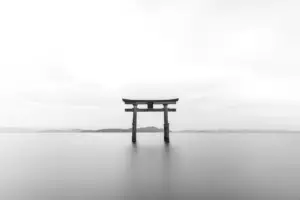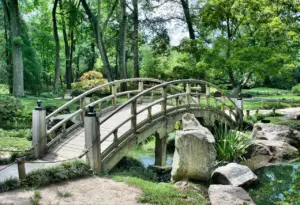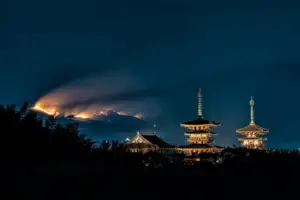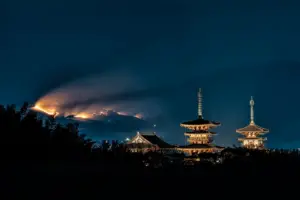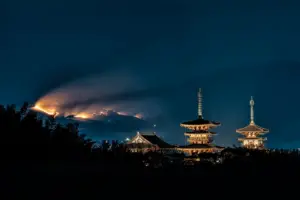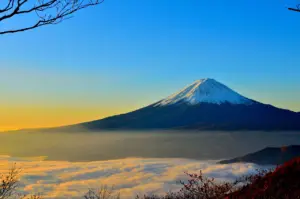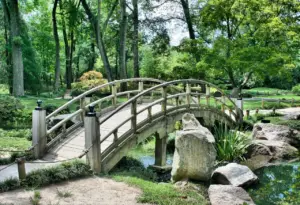When it comes to learning about Japanese mythology, visiting sacred sites is a must. These sites are not only visually stunning, but they also carry a rich history and spiritual significance that dates back centuries. From the iconic Mount Fuji to the lesser-known Takachiho Gorge, there are numerous places in Japan that are steeped in mythology.
In this article, you will explore five of the most sacred sites associated with Japanese mythology and learn about their significance in Japanese culture. As you delve into the world of Japanese mythology, you will discover that many of the sacred sites are associated with Shintoism, a religion that is deeply ingrained in Japan’s culture and history.
You will also find that several of the sites are located in remote areas of Japan, surrounded by stunning natural landscapes that enhance their spiritual significance. Whether you are interested in exploring Japan’s spiritual heritage or simply want to marvel at the country’s stunning landscapes, visiting these sacred sites is a must.
So, without further ado, let’s dive into the five most sacred sites associated with Japanese mythology.
Key Takeaways
- There are numerous sacred sites in Japan that carry rich history and spiritual significance, many of which are associated with Shintoism.
- Some of the most important sacred sites in Japan include Ise Grand Shrine, Mount Fuji, Kumano Kodo pilgrimage routes, Itsukushima Shrine, Takachiho Gorge, Kyushu, Amano Iwato Shrine, Udo Shrine, Izumo Taisha, Yoshino Mountain Range, Kinpusen-ji, Omine, and Hiraizumi.
- Climbing Mount Fuji during peak season and walking the Kumano Kodo are seen as physical and spiritual challenges that can cultivate inner peace and seek blessings from the goddess.
- Udo Shrine’s sacred spring is believed to bring good fortune in love and fertility, while Chuson-ji and Motsu-ji temples are UNESCO World Heritage Sites known for their historical significance and beautiful gardens.
Ise Grand Shrine
If you’re looking for a sacred site that embodies the essence of Japanese mythology, you won’t want to miss the Ise Grand Shrine. This shrine is considered to be the most important Shinto shrine in Japan.
It is dedicated to the sun goddess Amaterasu, who is believed to be the ancestor of the imperial family.
Located in the city of Ise in Mie Prefecture, the Ise Grand Shrine is actually a complex of over 100 shrines spread out over several square miles.
The main shrine, called the Naiku, is dedicated to Amaterasu, while the Geku shrine is dedicated to Toyouke, the goddess of agriculture and industry.
The shrines are rebuilt every 20 years in a traditional ceremony called Shikinen Sengu. This is done to renew the spiritual energy of the site and to keep the tradition alive for future generations.
Visiting the Ise Grand Shrine is an unforgettable experience that will transport you back in time to the roots of Japanese culture and mythology.
Mount Fuji
So you want to know more about Mount Fuji? Well, this majestic mountain is not just a symbol of Japanese identity, but also a sacred site in Shintoism.
The climbing season, which runs from July to September, attracts thousands of hikers every year, eager to summit this iconic peak.
But Mount Fuji is more than just a physical challenge – it holds immense cultural significance and is revered as a symbol of Japan’s natural beauty and spiritual heritage.
A Symbol of Japanese Identity
Being a symbol of Japanese identity, these sacred sites associated with Japanese mythology evoke a strong sense of pride and cultural heritage among Japanese people.
Mount Fuji, for instance, isn’t only the highest mountain in Japan, but it’s also regarded as a sacred site where the goddess Sengen-Sama is believed to reside. It’s a source of inspiration for poets, artists, and musicians, and its iconic shape has become a symbol of Japan worldwide.
However, Mount Fuji isn’t the only sacred site that carries such cultural significance in Japan.
Other sacred sites, such as the Kumano Kodo pilgrimage routes, the Itsukushima Shrine, and the Ise Grand Shrine, are also important cultural landmarks that are deeply rooted in Japanese mythology and history.
The Kumano Kodo pilgrimage routes, for instance, were once traveled by emperors and aristocrats seeking spiritual enlightenment.
The Itsukushima Shrine, located on the island of Miyajima, is known for its iconic torii gate that appears to be floating on water during high tide.
The Ise Grand Shrine, on the other hand, is considered the most sacred shrine in Japan, and is dedicated to the sun goddess Amaterasu.
These sacred sites not only hold an important place in Japanese mythology and religion, but also serve as a reminder of Japan’s cultural heritage and identity.
Sacred Mountain in Shintoism
You may not know that in Shintoism, mountains hold a special significance and are considered to be the dwelling place of kami, or gods. Among the most sacred mountains in Japan is Mount Fuji, which is said to embody the essence of Japan and is revered as a symbol of the nation’s culture and spirit.
Mount Fuji is also a popular destination for pilgrims seeking to pay their respects to the kami who reside there. In addition to Mount Fuji, there are many other sacred mountains in Japan that are considered to be important sites in Shinto mythology.
For example, Mount Hiei is a significant site for the Tendai sect of Buddhism, which was influenced by Shintoism and incorporates many Shinto practices. Other notable sacred mountains include Mount Takao, Mount Kurama, and Mount Koya, all of which are associated with important figures in Japanese mythology.
These mountains are not only revered for their spiritual significance but also for their natural beauty, which is said to inspire awe and reverence in those who visit them.
Climbing Season and Cultural Significance
If you’re planning to climb Mount Fuji, it’s important to note that the climbing season is limited and typically runs from early July to mid-September. This is due to safety concerns and the unpredictable weather conditions during the rest of the year.
The peak season is usually during the Obon Festival in August, where thousands of people come to climb the mountain as part of a spiritual pilgrimage.
Climbing Mount Fuji has a significant cultural significance in Japanese mythology. It is believed to be the dwelling place of the goddess Sengen-Sama, who is the deity of the mountain.
As such, it is considered a sacred site and has been a place of worship for centuries. Climbing Mount Fuji is seen as a way to pay homage to the goddess and seek her blessings.
It is also believed that climbing the mountain during the peak season can bring good luck and fortune to the climber. As you climb the mountain, you’ll come across many shrines and temples that have been built along the trail, each with its own unique significance and history.
Kumano Kodo
If you’re looking for a unique spiritual experience in Japan, then you might want to consider exploring the Kumano Kodo.
This network of pilgrimage routes has been an important site for both Shintoism and Buddhism for over a thousand years.
Along the way, you’ll encounter stunning natural scenery and impressive architecture, making it a truly unforgettable journey.
A Network of Pilgrimage Routes
When traveling through Japan, it’s easy to get caught up in the hustle and bustle of the cities, but did you know that there’s a network of pilgrimage routes connecting sacred sites associated with Japanese mythology?
These routes, known as the Kumano Kodo, were used by emperors, samurais, and commoners alike for over a thousand years. They lead through forests, mountains, and valleys, passing by shrines and temples dedicated to Shinto and Buddhist deities, as well as natural landmarks believed to house spirits and gods.
The Kumano Kodo is divided into three main routes, each with its own unique sights and experiences. The Nakahechi route, considered the main route, spans 30 kilometers from Tanabe City to Kumano Hongu Taisha, passing by the iconic Torii gates of the Oyunohara shrine.
The Kohechi route, starting from Kyoto, crosses the Kii Mountains and offers stunning views of the surrounding landscapes. The Iseji route, connecting the Ise Grand Shrines to Kumano Sanzan, is a less traveled but equally rewarding route.
Walking these routes not only offers a physical challenge but also a spiritual one, as pilgrims reflect on their own journeys and connect with the divine.
Spiritual Significance in Shintoism and Buddhism
Experience the profound spiritual significance of the Kumano Kodo pilgrimage routes in both Shintoism and Buddhism. These routes have been used for over a thousand years for spiritual purification and enlightenment.
Here are some of the ways in which the Kumano Kodo pilgrimage routes hold spiritual significance:
- The routes are believed to be a path to the divine. By walking the routes, one can connect with the spiritual realm and receive blessings from the gods and ancestors.
- The routes are a symbol of the interconnectedness of all things. As you walk the paths, you can feel a sense of unity with nature and the universe, and understand the importance of living in harmony with all beings.
- The routes are a way to cultivate inner peace and mindfulness. As you walk, you can meditate on the present moment and let go of worries and distractions, allowing yourself to fully immerse in the experience.
- The routes honor the spirits of those who have walked before us. By following in the footsteps of pilgrims who have journeyed before us, we show respect and gratitude for their spiritual legacy and the wisdom they’ve left behind.
- The routes offer a sense of community and shared experience. As you walk alongside other pilgrims, you can share in the joy and challenges of the journey, and create meaningful connections with people from all walks of life.
The Kumano Kodo pilgrimage routes hold a deep and meaningful spiritual significance in both Shintoism and Buddhism. By walking these paths, one can connect with the divine, cultivate inner peace, and honor the spiritual legacies of those who’ve come before us.
Take the time to experience the beauty and depth of these routes, and allow yourself to be transformed by the profound spiritual energy they hold.
Nature and Architecture along the Routes
You’ll be awed by the stunning blend of nature and architecture that you’ll encounter along the Kumano Kodo pilgrimage routes. The Kumano Kodo routes are known for the breathtaking natural scenery that they offer.
Along the way, you’ll see towering mountains, lush forests, and crystal-clear streams. The routes are also dotted with various shrines, temples, and other religious sites that are intricately woven into the natural landscape.
What’s truly remarkable about the Kumano Kodo pilgrimage routes is the way that the architecture of the religious sites blends seamlessly with the surrounding nature. The shrines and temples are often built using natural materials like wood and stone, and their designs are inspired by the shapes and forms of the natural world.
This creates a sense of harmony between the man-made structures and the natural environment, and adds to the overall spiritual atmosphere of the pilgrimage. Whether you’re a religious pilgrim or simply a lover of nature and architecture, the Kumano Kodo routes are sure to leave you in awe.
Itsukushima Shrine
The Itsukushima Shrine is a breathtakingly beautiful and sacred site, steeped in Japanese mythology. Located on the island of Miyajima, just a short ferry ride from Hiroshima, this shrine is dedicated to the Shinto goddess of the sea, fertility, and the arts, Benzaiten.
Its main torii gate, which appears to float on the water during high tide, is one of the most iconic symbols of Japan and has been designated as a UNESCO World Heritage Site. The shrine’s architecture is a testament to the skill and creativity of its builders. Its main hall, built in the 16th century, features a thatched roof and intricate carvings on its wooden pillars and beams.
The surrounding buildings, including a Noh theater and a prayer hall, are equally impressive. Visitors can explore the shrine’s many paths and bridges, taking in the stunning views of the surrounding mountains and sea. The Itsukushima Shrine is truly a must-visit destination for anyone interested in Japanese culture and history.
- The shrine is also known as the ‘Floating Torii Gate’ due to its unique location and appearance during high tide.
- The shrine’s Noh theater is one of the oldest in Japan and is still used for performances today.
- The shrine’s vermilion-lacquered buildings have been preserved through careful maintenance and restoration efforts over the centuries.
Takachiho Gorge
If you’re looking for a scenic wonder in Kyushu associated with Japanese mythology, head over to Takachiho Gorge.
This stunning natural attraction is believed to be the site where the goddess Amaterasu descended from the heavens and brought light back to the world.
As you explore the gorge, you’ll come across stunning waterfalls, lush greenery, and breathtaking rock formations that are sure to leave you in awe.
So, get ready to immerse yourself in the legend of Amaterasu’s descent and the natural beauty of Takachiho Gorge.
A Scenic Wonder of Kyushu
Don’t miss out on experiencing the breathtaking beauty of Kyushu, a scenic wonder that is sure to leave you in awe. Kyushu is the third largest island in Japan, located in the southwestern part of the country. It’s known for its stunning natural landscapes, hot springs, and cultural attractions.
Some of the most popular destinations in Kyushu include Mount Aso, Kumamoto Castle, and the hot springs town of Beppu.
For those interested in sacred sites associated with Japanese mythology, Kyushu is home to several significant locations. One such site is the Amano Iwato Shrine, located in the city of Takachiho. This shrine is dedicated to the sun goddess Amaterasu and is believed to be the location where she hid herself in a cave, causing the world to plunge into darkness.
Another important shrine in Kyushu is the Usa Jingu, located in the city of Usa. This shrine is dedicated to Hachiman, the god of war and the patron saint of samurai. It’s said that Hachiman was born in Kyushu and that the shrine was built on the spot where he descended to earth.
Associated with Japanese Mythology
Experience the enchanting allure of Kyushu’s mythical locations, with shrines dedicated to powerful deities and legends that will transport you back in time. These sacred sites are deeply rooted in Japanese mythology and offer a glimpse into the spiritual beliefs of ancient Japan.
One such site is the Amano Iwato Shrine, located in the mountains of Takachiho. This shrine is dedicated to the sun goddess Amaterasu, who is said to have hidden in a cave in the mountains, plunging the world into darkness. It’s believed that the other gods lured her out of the cave with a mirror, and her return brought light back to the world. The shrine is built around the cave and offers a stunning view of the surrounding mountains.
Another sacred site associated with Japanese mythology is the Udo Shrine, located on the eastern coast of Miyazaki prefecture. This shrine is dedicated to the god Susanoo, who is said to have slain an eight-headed dragon and married the goddess of fertility, Inadahime. The shrine is built into a cave on the side of a cliff overlooking the sea, and visitors can take a narrow path down to the shore to collect water from a sacred spring. Legend has it that drinking this water will bring good fortune in love and fertility. The Udo Shrine also features a unique torii gate, carved from a single block of volcanic rock and suspended over the sea.
These sacred sites are not only beautiful and awe-inspiring, but they also offer a glimpse into the rich history and mythology of Japan. A visit to these locations is a must for anyone interested in the spiritual beliefs and culture of ancient Japan.
The Legend of Amaterasu’s Descent
You’ll be captivated by the legendary story of Amaterasu’s descent. She emerged from the cave in the mountains of Takachiho and brought light back to the world. According to Japanese mythology, Amaterasu was the goddess of the sun and the most important deity in the Shinto religion. She was one of the three children born from the god Izanagi’s purification after his journey to the underworld.
The story goes that Amaterasu’s brother, Susanoo, had caused chaos and destruction in the heavens. This caused Amaterasu to retreat into a cave and hide. The world was plunged into darkness and it was only through the efforts of the other gods that Amaterasu was eventually persuaded to emerge and bring light back to the world.
Today, the cave where Amaterasu hid is a popular destination for tourists and pilgrims who come to pay their respects to the goddess and learn more about the rich mythology of Japan.
Izumo Taisha
If you’re visiting Japan, make sure to visit Izumo Taisha, a sacred site steeped in Japanese mythology. Located in the Shimane prefecture, this Shinto shrine is considered to be one of the most important religious sites in Japan.
Here are just a few reasons why Izumo Taisha should be on your list of must-visit places:
- The shrine is dedicated to the god of marriage and relationships, making it a popular destination for couples seeking blessings for their unions.
- The architecture of the shrine is distinct from other Shinto shrines, with a large open space in front of the main building where visitors can offer prayers and make offerings.
- The shrine is surrounded by a forest of giant trees, adding to its mystical and spiritual atmosphere.
In addition to its significance as a religious site, Izumo Taisha is also linked to many Japanese legends and folklore. According to one story, the god of the shrine, Okuninushi, once held a contest to determine who would become the ruler of Japan. This competition is said to have taken place on the grounds of Izumo Taisha, and the winner was the god of the sun, Amaterasu.
The shrine is also said to be the site where the gods gather every October to discuss the fates of humans for the upcoming year. Whether you’re interested in mythology, architecture, or simply want to experience the spiritual energy of Japan, Izumo Taisha is not to be missed.
Yoshino Mountain Range
Get ready to be awed by the breathtaking scenery of the Yoshino Mountain Range, where the vibrant colors of cherry blossoms in spring and the stunning foliage in autumn will leave you speechless.
This mountain range, located in the Nara Prefecture, is considered to be one of the most sacred sites in Japan, with a rich history dating back to ancient times.
It is said that the gods of Shinto, the indigenous religion of Japan, reside on these mountains, making them an important pilgrimage site for believers.
The Yoshino Mountain Range is home to several shrines and temples, including Kinpusen-ji, one of the most significant temples in Japan.
This temple is said to have been founded over 1,200 years ago and is known for its impressive architecture and beautiful gardens.
Another notable site in the mountain range is Omine, a peak that has been worshipped as a sacred site for over 1,300 years.
Visitors can hike up to the summit and enjoy stunning views of the surrounding landscape.
The Yoshino Mountain Range is truly a must-see destination for anyone interested in Japanese mythology and spirituality.
Hiraizumi
Now that you have learned about the majestic Yoshino Mountain Range, let us take a journey to the historical town of Hiraizumi. Located in the southern part of Iwate Prefecture, Hiraizumi is known for its UNESCO World Heritage Sites and is considered the cultural and administrative center of the Tohoku region in northern Japan.
Hiraizumi is home to two significant sites that are associated with Japanese mythology – the Chuson-ji Temple and the Motsu-ji Temple. These temples are situated near each other, and both are surrounded by beautiful gardens and stunning scenery. Let us take a closer look at these temples in the table below:
| Temple | Description | Significance |
|---|---|---|
| Chuson-ji Temple | A Buddhist temple founded in 850 AD, it is the home of the Konjikido, a building entirely covered in gold leaf and considered as a national treasure. | It is a UNESCO World Heritage Site and a symbol of the golden age of Hiraizumi. It is known for its historical and cultural significance. |
| Motsu-ji Temple | A former Buddhist temple that was once one of the grandest temples in the Tohoku region, it is now a site of historical ruins. | It is also a UNESCO World Heritage Site and is known for its beautiful gardens and historical significance. |
Hiraizumi is a must-visit destination for those who are interested in Japanese history and culture. Its beautiful temples and gardens are not only a testament to its rich past but also a reminder of the importance of preserving cultural heritage.
Frequently Asked Questions
What is the significance of the number 5 in Japanese mythology and why are these particular locations considered sacred?
The number 5 holds great significance in Japanese mythology, representing the five elements of earth, water, fire, wind, and void. These elements are believed to be essential to life and are deeply interconnected with the natural world.
The sacred sites associated with Japanese mythology are considered holy because they are believed to be imbued with spiritual energy and divine power. Each location is connected to a specific deity or legend that is revered in Japanese culture.
The five sacred sites, in particular, are believed to be gateways to the divine realm, where one can commune with the gods and experience a sense of transcendence. These sites are considered sacred because they represent the essence of Japanese spirituality and the deep connection between nature, mythology, and human experience.
Are there any specific rituals or customs associated with visiting these sacred sites?
When visiting sacred sites associated with Japanese mythology, it’s important to be aware of the customs and rituals that are often observed.
For example, it’s common to offer a small prayer or make a donation before entering the site. Visitors may also cleanse themselves by washing their hands and mouth before approaching the shrine or altar.
It’s considered respectful to bow or clap your hands twice before praying, and to bow again after finishing. Some sites may also have specific customs, such as making a wish by writing it on a wooden plaque and hanging it on a designated area.
Overall, it’s important to approach these sacred sites with reverence and respect, following the customs and traditions that have been passed down through generations.
What role do these sites play in contemporary Japanese culture and spirituality?
In contemporary Japanese culture and spirituality, Sacred Sites Associated with Japanese Mythology hold a significant role. These sites are revered for their historical and cultural significance, as well as for their spiritual and religious importance.
They serve as a connection to Japan’s ancient past and are seen as a way to honor and pay respect to their ancestors. The sites are also a popular destination for cultural tourism, attracting both domestic and international visitors.
Many Japanese people visit these sites to seek spiritual guidance, offer prayers, and participate in various religious rituals. Overall, these sacred sites continue to play an important role in contemporary Japanese culture and spirituality.
Have any significant archaeological discoveries been made at these sites that shed light on ancient Japanese beliefs and practices?
Archaeological discoveries have shed light on ancient Japanese beliefs and practices at various sacred sites. For instance, excavations at the Ise Jingu shrine revealed that it had been rebuilt every 20 years for over a millennium, in accordance with the Shinto belief in the cyclical nature of life and death.
Another significant discovery was made at the Takamatsuzuka Tomb, where a mural depicted a celestial maiden descending from heaven, offering a gift to a prince. This mural suggests that ancient Japanese people believed in a divine world and that their rulers had divine connections.
At the Kofun period burial mounds, artifacts such as bronze mirrors and weapons were discovered, indicating that these sites were not only for burial but also for religious ceremonies. These archaeological findings demonstrate the deep spiritual significance of these sacred sites in ancient Japanese beliefs and practices.
How have these sites been impacted by modernization and tourism, and what measures are being taken to preserve their cultural and spiritual significance?
If you’re curious about the impact of modernization and tourism on sacred sites associated with Japanese mythology, there’s good news and bad news.
On one hand, the increased interest in these sites has led to greater awareness and appreciation of their cultural and spiritual significance. However, it has also put them at risk of damage or destruction due to overcrowding, pollution, and other factors.
To address these concerns, various measures are being taken to preserve and protect these sites. For example, some locations have implemented limits on the number of visitors or hours of operation, while others have introduced educational programs to help visitors understand and respect the history and traditions of these sites.
Additionally, there are ongoing efforts to restore or repair damaged structures and artifacts, and to promote sustainable tourism practices that prioritize the long-term health and preservation of these important cultural landmarks.
Conclusion
Congratulations! You’ve just explored five of the most sacred sites associated with Japanese mythology.
Each of these locations has a rich history and unique significance that’s deeply rooted in Japanese culture and religion. From the Ise Grand Shrine, which is considered the most important Shinto shrine in Japan, to the Takachiho Gorge, which is believed to be the site where the gods descended to earth, these locations offer a glimpse into the rich mythology and spirituality of Japan.
Whether you’re a history buff, a spiritual seeker, or simply someone who appreciates breathtaking natural landscapes, these sacred sites are definitely worth a visit.
So why not plan a trip to Japan and see these incredible locations for yourself? You won’t regret it!




































